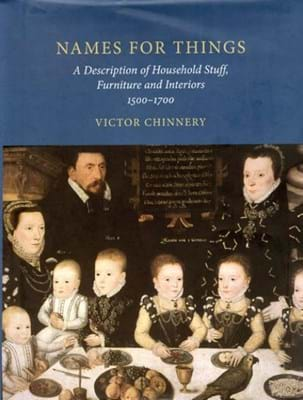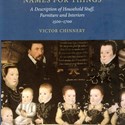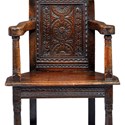Book review
Names for Things: A Description of Household Stuff, Furniture and Interiors 1500-1700, published in late 2016, does just that.
This was a manuscript that Chinnery, author of the standard reference work on oak furniture, was collating throughout his 50-year career as dealer, collector, author and historian.
Its starting point was the terms found in the many probate inventories that survive from the 16th and 17th centuries and Randle Holme’s descriptive work on domestic items An Academie of Armoury…, 1649.
Before he died in 2011, Chinnery left notes as to how a book might be published with the posthumous work completed in recent years by his wife Jan with the aid of a range of specialists from the academic and the commercial worlds.
The resulting 324-page hardback – both original and creative in its approach – amounts to a dictionary of Tudor and Stuart furnishing terms.
Each A-Z entry gives a detailed description of the object backed up by documentary evidence which aim to explain how the objects would have been used in a period setting.
Many words and phrases will be familiar to learned dealers and collectors.
Others perhaps less so. While blackjacks, bleeding bowls, the blunderbuss and the backstool remain relatively common terms in auction catalogues, the banker (a textile cover or cushion for a bench or settle), the beoube (a Japanese lacquer screen) or a brandreth (a three-footed trivet) are not.
It seems too that the precise meaning of some words has changed over time. The term chair, for example, did not come to mean any form of seating furniture until after this period.
The welcome inclusion here of many modern collecting terms also underlines the role antiquarianism has played in our ‘naming of things’. It appears that the caqueteuse chair, the ox-eye cup and the mortuary sword are all inventions of Victorian romanticism.
Of course a work such as this can never claim to be ‘complete’ – as Dr Johnson said, dictionaries are remembered for their omissions – but few could attempt such a daunting project and hope to get this far.
A worthy legacy of a great servant to furniture history.
Chinnery in practice
According to the Names for Things, a caqueteuse (meaning a ‘gossip’s chair’) was originally used to describe a low-seated upholstered chair popular in 16th century France.
However, “modern authorities have incorrectly applied it to a distinctive English and Scottish form of wooden panel-back armchair” with splayed arms and seat.
The form is particularly associated with Salisbury where the James I example pictured here – probably created for an adolescent – was crafted c.1610-20. A comparable caqueteuse chair, with a very similar carved back panel, is in the collection at Hall’s Croft, Stratford-Upon-Avon, Warwickshire.
Common features among a series of chairs led Victor Chinnery to suggest they were from a single workshop, perhaps that of the specialist Salisbury carver Humphrey Beckham (b.1588).
Having failed to match expectations of £10,000-15,000 in September 2016, this example sold six months later at Bonhams with revised hopes at £7000.


















